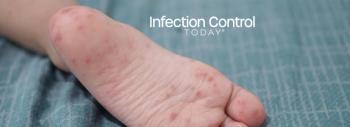
Researchers Discover How Staphylococcus aureus Paralyzes our Immune Defenses
When golden staph (Staphylococcus aureus) enters our skin it can identify the key immune cells and 'nuke' our body's immune response. Now we know how, thanks to an international research group led by dermatologists from the Centenary Institute and the University of Sydney. Using state-of-the art microscopy techniques, the team identified the key immune cells that orchestrate the body's defenders against invading golden staph, and also how the bacteria can target and destroy these cells, circumventing the body's immune response. Golden staph is the multi-drug resistant bacterium that is the scourge of hospitals.
This shows the depletion of macrophages (in green) after injection of S. aureus (orange-red material) into the skin. Normal skin is on the left; infected skin is on the right. Image courtesy of Centenary Institute/Nature Immunology
When golden staph (Staphylococcus aureus) enters our skin it can identify the key immune cells and 'nuke' our body's immune response. Now we know how, thanks to an international research group led by dermatologists from the Centenary Institute and the University of Sydney. Using state-of-the art microscopy techniques, the team identified the key immune cells that orchestrate the body's defenders against invading golden staph, and also how the bacteria can target and destroy these cells, circumventing the body's immune response. Golden staph is the multidrug-resistant bacterium that is the scourge of hospitals.
The details of the study have been published today in Nature Immunology. It also involved researchers from The Univeristy of Sydney's School of Biological Sciences, Monash University, Singapore Immunology Network (A*STAR), and Harvard Medical School.
"Staphylococcus aureus kills many, many people around the world. In fact, more than tuberculosis and AIDS put together. And the skin is its primary entry point into the body, so it important to understand what happens in the skin," says professor Wolfgang Weninger, head of the Immune Imaging Research Program at Centenary and coordinator of the study.
Using techniques they have developed over the past decade, the research team was able to mark the different cells of the immune system with fluorescent tags of different colours. They then introduced bacteria labeled with similar colored tags, and observed the unfolding battle live under a multiphoton microscope.
Source: Centenary Institute, University of SydneyÂ
Â
Newsletter
Stay prepared and protected with Infection Control Today's newsletter, delivering essential updates, best practices, and expert insights for infection preventionists.






